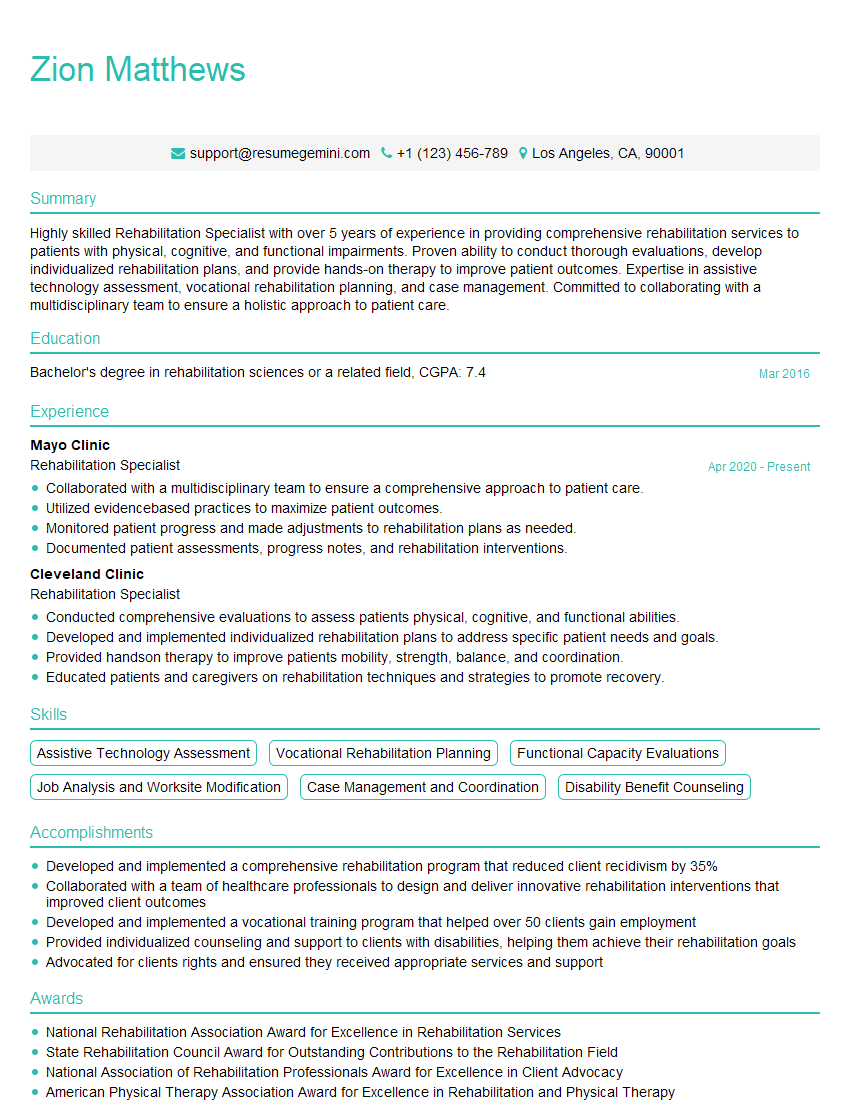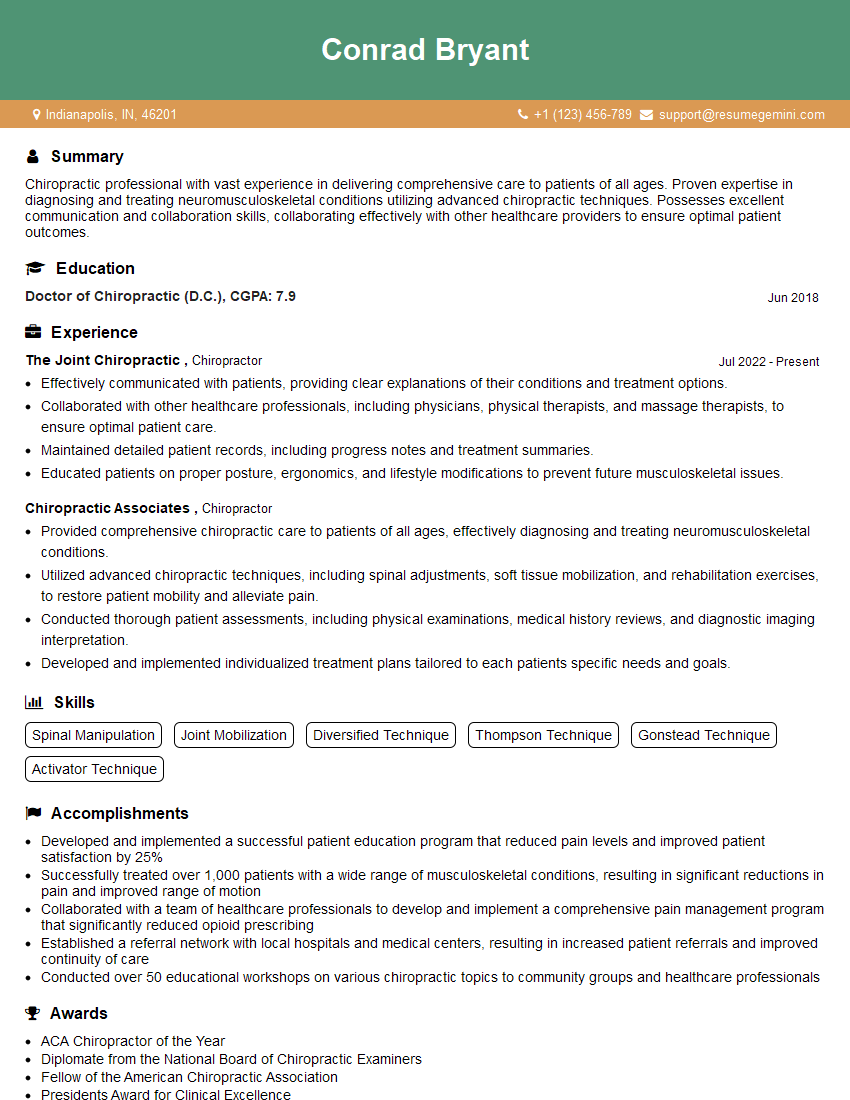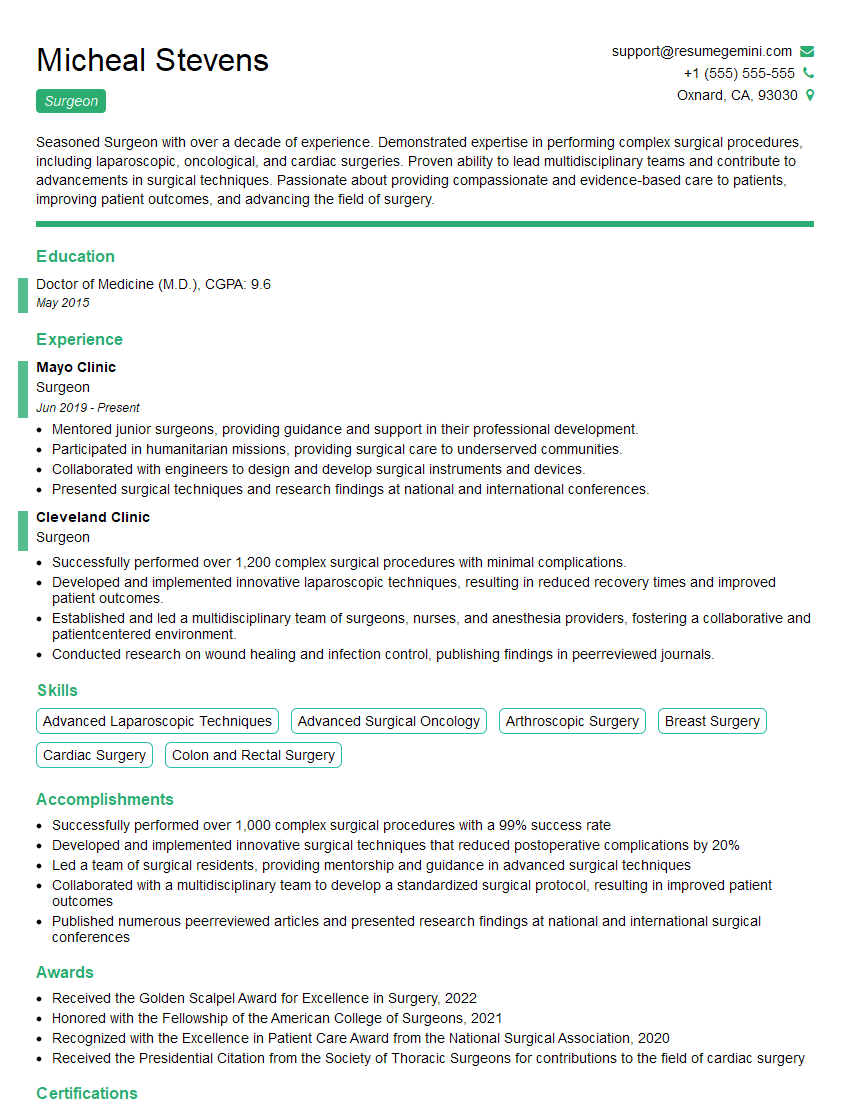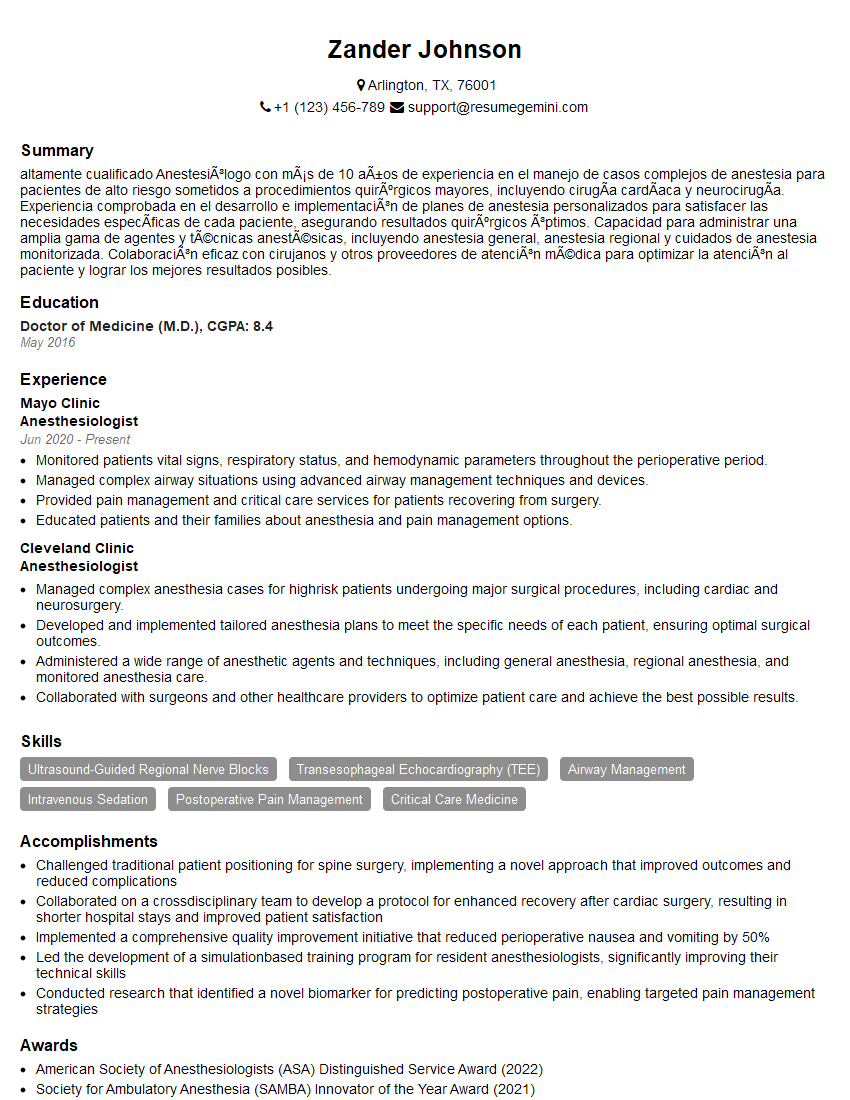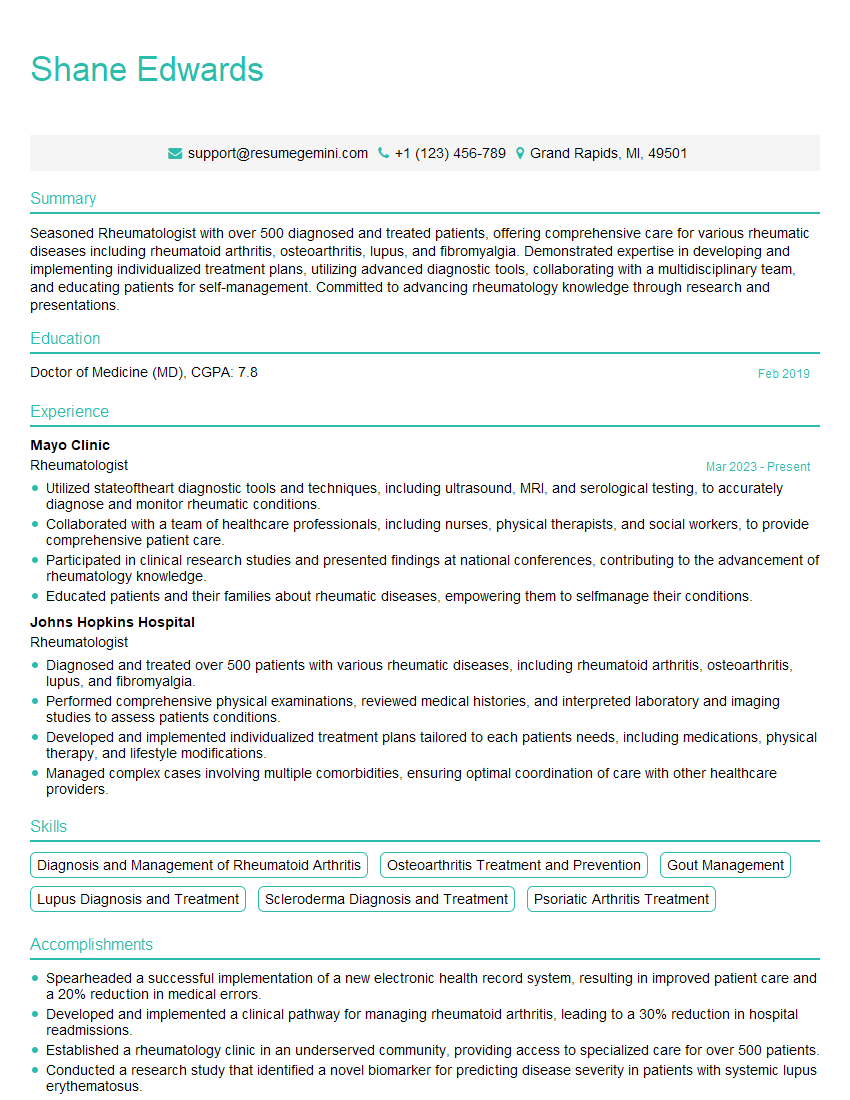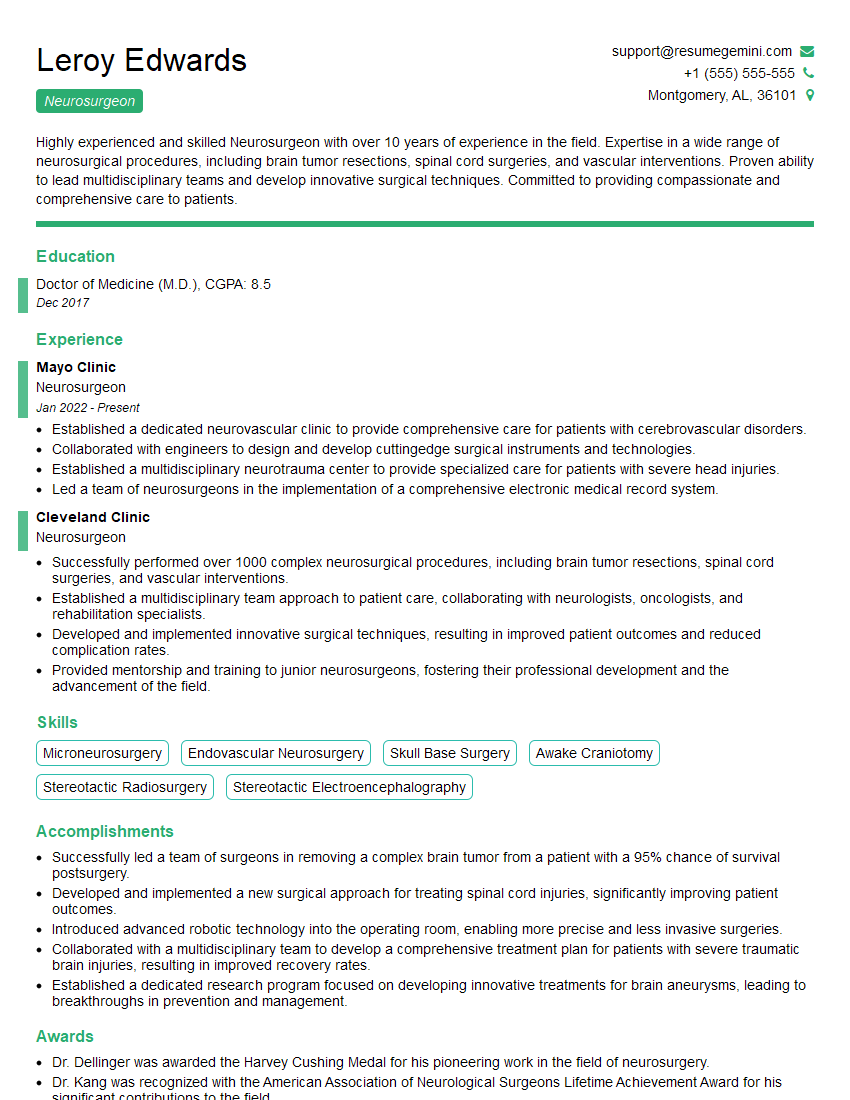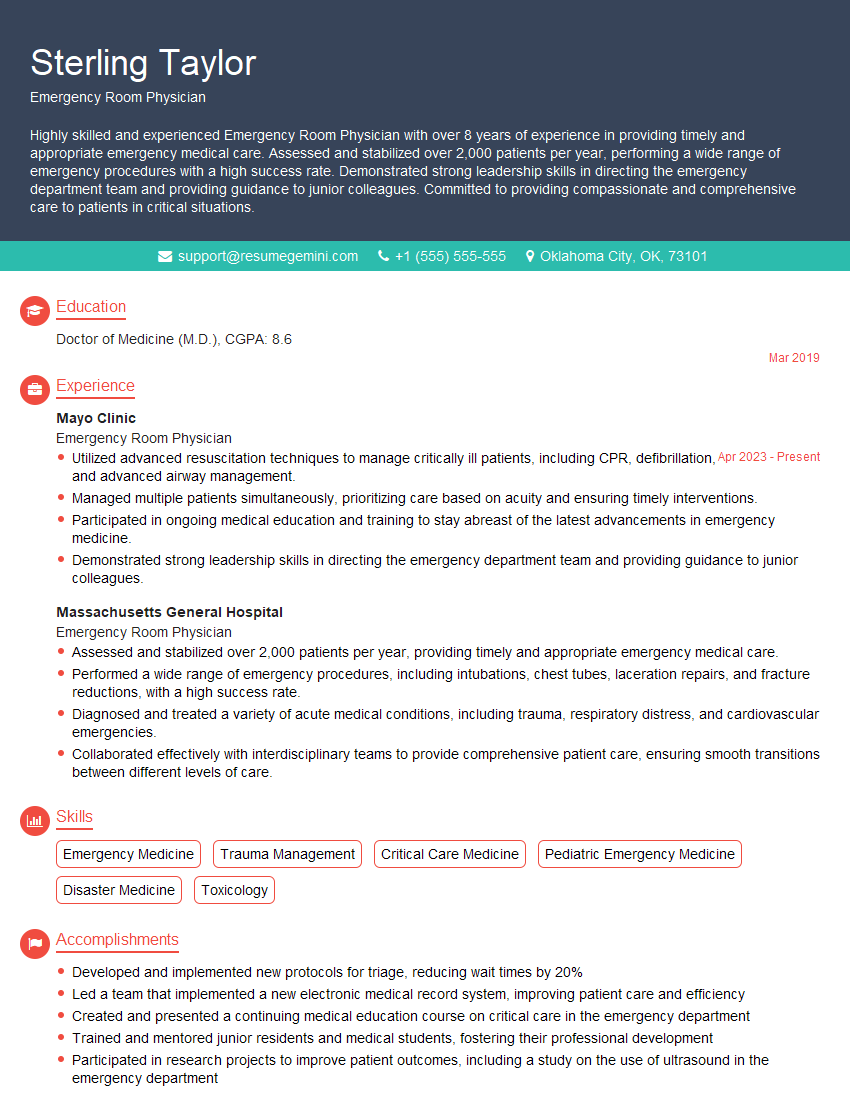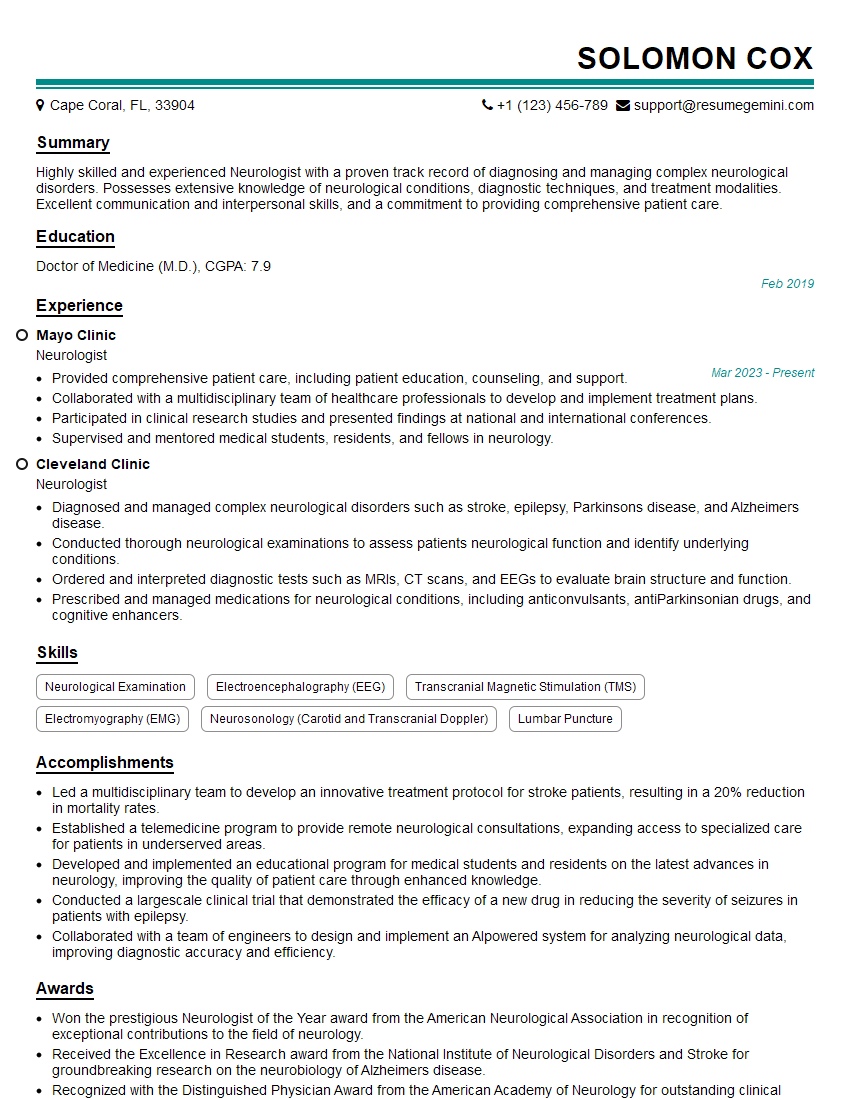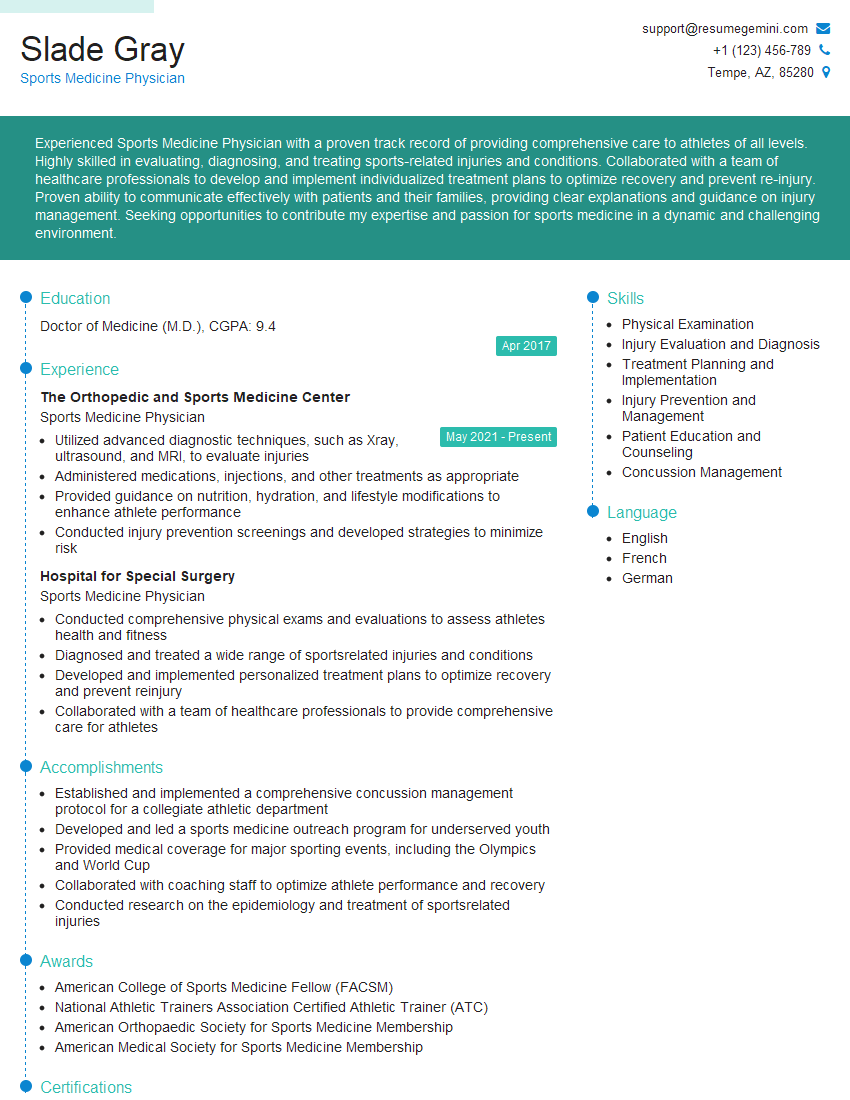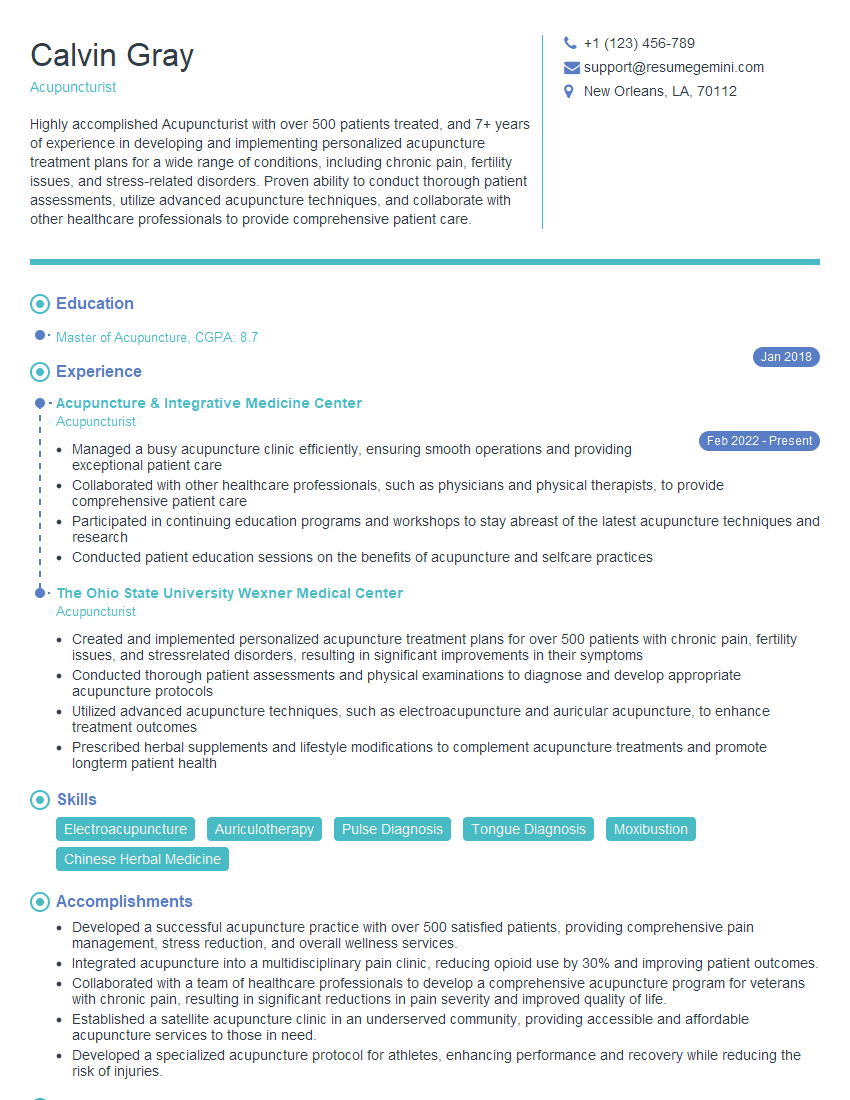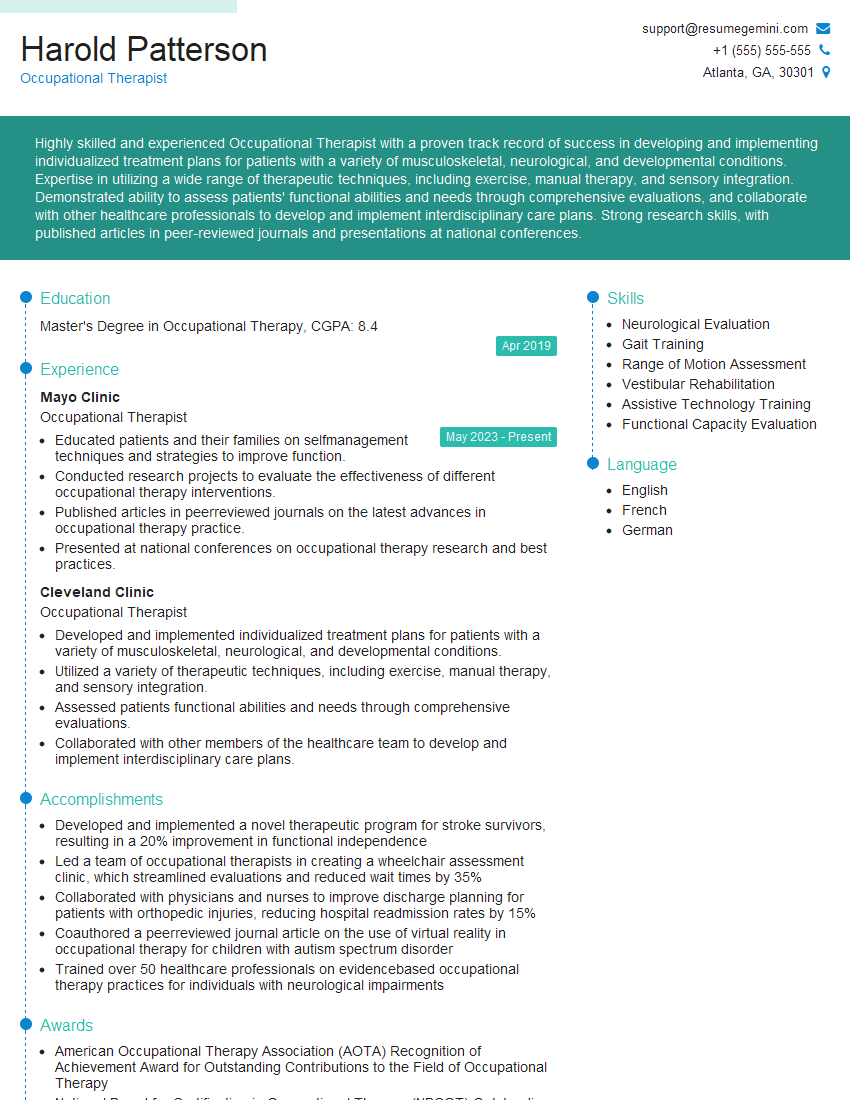Interviews are more than just a Q&A session—they’re a chance to prove your worth. This blog dives into essential Pain Tolerance interview questions and expert tips to help you align your answers with what hiring managers are looking for. Start preparing to shine!
Questions Asked in Pain Tolerance Interview
Q 1. Explain the difference between pain perception and pain tolerance.
Pain perception and pain tolerance are distinct but related concepts. Pain perception refers to the sensory experience of pain – the actual feeling of pain itself. It’s the process by which your nervous system detects and interprets noxious stimuli as painful. Think of it as the intensity of the ‘pain signal’ your brain receives. Pain tolerance, on the other hand, is a person’s capacity to endure pain; it’s the level of pain a person is willing or able to withstand before outwardly expressing distress or requesting relief. It’s a subjective experience influenced by many factors beyond the pain signal itself.
For example, two people might experience the same level of tissue damage (e.g., a minor burn). One person might perceive the burn as intensely painful (high pain perception), while another might feel it less intensely. However, the person with the higher pain perception might have a higher pain tolerance and not ask for pain relief, whereas the person with the lower pain perception might request relief sooner even though they felt less pain initially.
Q 2. Describe the physiological mechanisms involved in pain modulation.
Pain modulation is a complex process involving multiple physiological mechanisms that either amplify or dampen pain signals. It’s like a volume control for your pain experience. Key players include:
- Descending Inhibitory Pathways: These pathways originate in the brain and spinal cord and release endogenous opioids (like endorphins) and other neurotransmitters that block pain signals before they reach the brain. This is your body’s natural painkiller system. Think of it as a gatekeeper reducing the intensity of pain signals.
- Peripheral Nervous System (PNS): The PNS can influence pain through the release of various substances at the site of injury, some of which increase pain (pro-inflammatory mediators) and others decrease it (anti-inflammatory mediators). This explains why applying ice to an injury can help, as it reduces inflammation and thus, pain.
- Spinal Cord: The spinal cord acts as a central relay station, integrating and modifying pain signals before transmitting them to the brain. This is where many analgesic medications work, affecting the transmission of pain signals at the spinal level.
- Brain: The brain’s role is to interpret the incoming pain signals and determine the emotional and behavioral response to pain. Cognitive factors like stress and anxiety can significantly impact the brain’s processing of pain signals.
These systems interact intricately to modulate the overall pain experience. For instance, during intense physical activity, endorphins are released, providing a natural pain-relieving effect – this explains the “runner’s high” phenomenon.
Q 3. How do you assess a patient’s pain tolerance level?
Assessing a patient’s pain tolerance is tricky because it’s subjective and influenced by many factors. There’s no single definitive test. Instead, we rely on a combination of methods:
- Pain Scales: Visual Analog Scales (VAS), Numeric Rating Scales (NRS), and Wong-Baker FACES Pain Rating Scale are common tools. These scales provide a numerical or visual representation of the patient’s pain intensity. However, it’s crucial to understand that these scales measure pain intensity, not tolerance.
- Observation: Assessing patients’ behavioral responses to pain—facial expressions, body language, vocalizations—can provide some clues about their pain experience, but it cannot directly measure tolerance.
- Patient Self-Report: The most valuable information comes directly from the patient. Asking about their past experiences with pain, how they usually cope with pain, and their current tolerance level is crucial. This provides context and insight into their pain management expectations.
- Contextual Factors: Considering the patient’s age, culture, previous experiences, and current health condition is crucial. What one person tolerates might be unbearable for another.
It’s important to remember that the goal is not to judge a patient’s tolerance but rather to understand their pain experience and provide appropriate pain management strategies based on their individual needs.
Q 4. What are the ethical considerations when managing pain in patients with high pain tolerance?
Managing pain in patients with high pain tolerance presents unique ethical challenges. The key issue is avoiding undertreatment due to misinterpretations. A patient might not express pain due to a high tolerance, stoicism, or fear of medication side effects, leading to unnecessary suffering.
- Respect for Patient Autonomy: We must respect the patient’s right to self-determination, even if their choices seem contrary to medical advice. However, this respect should not override the ethical obligation to alleviate suffering.
- Beneficence and Non-Maleficence: It’s crucial to weigh the potential benefits of pain treatment against the risks of side effects. For patients with a high tolerance, starting with lower doses of medication and closely monitoring their responses is vital.
- Communication: Open and honest communication is vital. Educating the patient about pain management options, including non-pharmacological approaches, is crucial. Addressing any anxieties or misconceptions surrounding pain medication is also important.
- Advocacy: In some cases, the healthcare provider might need to advocate for the patient, especially if the patient’s high pain tolerance leads to undertreatment.
The ethical approach involves proactively addressing potential undertreatment by engaging the patient in shared decision-making, emphasizing the importance of pain relief, and providing comprehensive and patient-centered care.
Q 5. Discuss various non-pharmacological methods for pain management.
Non-pharmacological methods play a significant role in pain management, particularly in complementing or reducing the reliance on medications. These methods include:
- Physical Therapy: Exercises, stretching, and manual therapies can improve mobility, reduce muscle tension, and enhance function, thereby easing pain.
- Cognitive Behavioral Therapy (CBT): CBT helps patients understand the relationship between their thoughts, feelings, and behaviors in managing pain, empowering them to develop coping strategies.
- Relaxation Techniques: Deep breathing, meditation, mindfulness, and progressive muscle relaxation can reduce stress, anxiety, and muscle tension, thus relieving pain.
- Transcutaneous Electrical Nerve Stimulation (TENS): TENS uses low-voltage electrical currents to stimulate nerves, blocking pain signals and producing a tingling sensation that can mask pain.
- Heat and Cold Therapy: Applying heat or ice to the painful area can reduce inflammation and muscle spasms, offering pain relief.
- Acupuncture: This traditional Chinese medicine technique involves inserting thin needles into specific points on the body to stimulate nerve pathways and reduce pain.
The effectiveness of these methods varies from person to person, and they often work best when combined with other approaches, including medication in some cases. A holistic and individualized plan is crucial.
Q 6. What are some common misconceptions about pain tolerance?
Several common misconceptions surround pain tolerance:
- High pain tolerance equates to stoicism or lack of pain: Patients with high tolerance still experience pain; they simply have a higher capacity to endure it without outward distress. It’s not about being stronger or tougher.
- Pain tolerance is constant: Pain tolerance can fluctuate depending on factors like mood, fatigue, stress, and the context of the pain.
- Pain tolerance is a reliable indicator of pain intensity: A high pain tolerance does not mean the pain isn’t severe; it only means the person can endure it better before seeking relief. It’s not a measure of pain severity but of the individual’s response threshold.
- Pain tolerance can be trained to be infinitely high: While strategies can help manage pain, individuals have inherent limits to their pain tolerance; it is not something that can be indefinitely increased through mental fortitude alone.
Addressing these misconceptions is crucial for providing effective and ethical pain management. Patients with high pain tolerance require careful assessment and tailored care to ensure their pain is adequately managed.
Q 7. How do psychological factors influence pain perception and tolerance?
Psychological factors significantly influence both pain perception and tolerance. These factors act through complex interactions within the nervous system and the brain, modifying how pain is experienced and managed.
- Anxiety and Depression: These conditions amplify pain perception and reduce tolerance, making pain feel more intense and less bearable. Anxiety increases the brain’s responsiveness to pain signals, while depression can lead to a heightened focus on pain.
- Stress: Chronic stress affects pain pathways, reducing pain tolerance and making individuals more vulnerable to pain. The body under chronic stress releases hormones that can sensitize pain receptors.
- Catastrophizing: A negative and exaggerated interpretation of pain can significantly increase its perceived intensity and reduce tolerance. This cognitive distortion intensifies the emotional response to pain.
- Coping Mechanisms: Effective coping strategies, such as relaxation techniques, mindfulness, and distraction, can positively influence both pain perception and tolerance. Negative coping styles, like avoidance and denial, can worsen the experience.
- Beliefs and Expectations: A person’s beliefs about pain and their expectations regarding treatment can affect their pain experience. Positive beliefs and expectations can enhance coping abilities and tolerance.
Understanding these psychological influences is crucial for comprehensive pain management. Addressing the psychological factors alongside physical treatment improves outcomes and improves quality of life for patients with chronic pain.
Q 8. Explain the gate control theory of pain.
The gate control theory of pain proposes that pain signals are modulated, not simply transmitted. Imagine a gatekeeper controlling the flow of information. This ‘gate’ is located in the spinal cord, and its opening and closing depends on the interaction between different types of nerve fibers.
Large-diameter fibers (A-beta fibers) carry sensory information about touch, pressure, and vibration. When these fibers are stimulated, they tend to ‘close the gate,’ reducing the transmission of pain signals from smaller fibers.
Small-diameter fibers (A-delta and C fibers) transmit pain signals. Stimulation of these fibers opens the gate, allowing pain signals to reach the brain.
Central control mechanisms, originating from the brain, can also influence the gate. For example, emotional factors, such as anxiety or fear, can increase the perception of pain by opening the gate further. Conversely, distraction or relaxation techniques can help close the gate, reducing pain.
In practical terms, this explains why rubbing an injured area can sometimes reduce pain: The stimulation of large-diameter fibers ‘closes the gate’ on the pain signals from small-diameter fibers. Similarly, therapies like transcutaneous electrical nerve stimulation (TENS) use this principle to provide pain relief.
Q 9. Describe the role of endorphins in pain modulation.
Endorphins are endogenous opioids, naturally occurring peptides produced by the body, acting as powerful pain modulators. They bind to opioid receptors in the brain and spinal cord, effectively blocking pain signals. Think of them as the body’s natural painkillers.
Endorphins work in a similar way to morphine or other opioid medications but are produced internally. They inhibit the release of substance P, a neurotransmitter that transmits pain signals. This reduction in substance P reduces pain perception.
The release of endorphins is triggered by various stimuli, including physical activity (like running), stress, and even laughter. This explains why you might feel less pain or a sense of euphoria after intense exercise or during a stressful situation (the ‘runner’s high’ is a prime example).
Clinically, understanding endorphins is crucial. We know that certain techniques, such as acupuncture or meditation, may stimulate endorphin release, offering non-pharmacological pain relief options for patients.
Q 10. What are the potential risks and benefits of different pain medications?
Different pain medications offer distinct benefits and risks. The choice depends heavily on the type, intensity, and duration of pain, as well as the patient’s overall health and history.
- Nonsteroidal anti-inflammatory drugs (NSAIDs): such as ibuprofen or naproxen, reduce pain and inflammation. Benefits include relative safety for short-term use. Risks include gastrointestinal issues (ulcers, bleeding), kidney problems, and cardiovascular effects at higher doses or with prolonged use.
- Opioids: such as morphine, oxycodone, or fentanyl, are powerful pain relievers but carry significant risks, including addiction, respiratory depression, constipation, and tolerance (needing higher doses over time). They are generally reserved for moderate to severe pain that doesn’t respond to other treatments and only used under strict medical supervision.
- Acetaminophen (paracetamol): reduces pain and fever but has less anti-inflammatory effect compared to NSAIDs. Relatively safe in recommended doses, but liver damage can occur with overdose.
Other medications, such as antidepressants or anticonvulsants, may be used to treat certain types of chronic pain, although their primary function isn’t pain relief. Each medication presents a risk/benefit profile that needs careful consideration for every individual patient. A thorough discussion of potential side effects and medication interactions is always necessary.
Q 11. How would you differentiate between acute and chronic pain in a patient?
Differentiating between acute and chronic pain is crucial for effective management. Acute pain is sudden and typically associated with a specific injury or illness, lasting less than three months. For example, a broken bone or a post-surgical incision causes acute pain. It usually resolves once the underlying cause is treated.
Chronic pain, on the other hand, persists for three months or longer, often beyond the normal healing time of an injury. The pain may or may not have a clear cause. Examples include fibromyalgia, chronic back pain, or neuropathic pain. Chronic pain significantly impacts a patient’s quality of life, impacting sleep, mood, and daily activities.
In practice, I would assess duration, intensity, location, and the presence of any underlying medical conditions to distinguish between them. The patient’s subjective report of the pain’s impact on their life is also crucial.
Q 12. What are some objective measures you can use to assess pain levels?
While subjective pain scales are important, objective measures provide additional valuable information. These measures aren’t perfect replacements for a patient’s description but supplement the assessment.
- Physiological measures: These include heart rate, blood pressure, and muscle tension. Increased heart rate and blood pressure can indicate pain, especially acute pain. However, these aren’t pain-specific.
- Biomarkers: Some biomarkers, like inflammatory markers (C-reactive protein), can indicate the presence of underlying conditions contributing to pain. They provide indirect evidence of pain’s severity and the body’s response.
- Functional assessments: Measuring a patient’s ability to perform daily activities (e.g., range of motion, ability to walk, grip strength) can indicate the impact of pain on their functional capacity. Tools like the Oswestry Disability Index are useful here.
It is vital to remember that objective measures often complement, rather than replace, the patient’s subjective report.
Q 13. How do you manage pain in patients with substance abuse history?
Managing pain in patients with a history of substance abuse requires a multi-faceted approach, emphasizing caution and close monitoring. The risk of opioid addiction is higher in this population.
My strategy includes:
- Careful opioid prescription: If opioids are necessary, I would use them judiciously, at the lowest effective dose for the shortest duration possible, with regular monitoring for signs of misuse or addiction.
- Alternative pain management strategies: Prioritizing non-pharmacological approaches such as physical therapy, cognitive behavioral therapy (CBT), and other modalities that may reduce reliance on opioids.
- Collaboration with addiction specialists: Consulting with addiction specialists to develop a comprehensive treatment plan addressing both pain and addiction simultaneously. This may involve medication-assisted treatment or other therapies.
- Regular drug screens: To assess adherence and prevent diversion of medication.
- Frequent patient evaluations: This includes close monitoring of pain levels, side effects, and any signs of medication misuse or withdrawal.
Ultimately, the goal is to provide effective pain relief while minimizing the risks associated with opioid use in this vulnerable population.
Q 14. Describe your experience with different pain scales (e.g., Visual Analog Scale, Numeric Rating Scale).
I have extensive experience with various pain scales, including the Visual Analog Scale (VAS) and the Numeric Rating Scale (NRS). The VAS is a 10-cm line anchored at one end with ‘no pain’ and at the other with ‘worst imaginable pain.’ Patients mark their pain level along the line. The distance from ‘no pain’ is measured to assess pain intensity.
The NRS is a numerical scale, usually 0-10, where 0 represents ‘no pain’ and 10 represents ‘worst imaginable pain.’ Patients select a number to represent their pain level. The NRS is easy to administer and understand, making it appropriate for diverse patient populations.
My experience shows that the choice of scale depends on factors such as the patient’s cognitive abilities and communication skills. While the NRS is widely used and easily understood, the VAS can be beneficial for individuals with language barriers or cognitive impairments. I often tailor my approach to the individual patient’s needs and preferences, ensuring that the pain assessment is both accurate and sensitive.
Q 15. What are some effective communication strategies when interacting with patients experiencing pain?
Effective communication with patients in pain requires a multifaceted approach focusing on empathy, active listening, and clear, concise explanations. It’s crucial to create a safe and trusting environment where patients feel comfortable expressing their experiences without judgment.
- Empathetic Listening: Start by truly listening to the patient’s description of their pain, paying attention not only to the location and intensity but also to its impact on their daily life, emotions, and relationships. A simple phrase like, “Tell me more about what that feels like,” can open up a deeper conversation.
- Using Clear and Simple Language: Avoid medical jargon and explain concepts in a way the patient can easily understand. For example, instead of saying “nociceptive pain,” describe it as “pain caused by damage to tissues.”
- Validating Their Experience: Acknowledge the patient’s pain and suffering. Phrases such as, “That sounds incredibly difficult,” or “I can understand why this is so frustrating,” can build rapport and demonstrate empathy.
- Shared Decision-Making: Involve the patient in developing a pain management plan. Discuss treatment options, their potential benefits and risks, and collaboratively choose the best approach based on their individual needs and preferences.
- Regular Follow-Up: Schedule regular follow-up appointments to monitor the effectiveness of the treatment plan, address any new concerns, and adjust the plan as needed. Consistent communication fosters trust and ensures optimal pain management.
For example, I recently worked with a patient who described their chronic back pain as a “constant burning sensation.” By actively listening and asking clarifying questions, I discovered that this pain significantly impacted their ability to care for their grandchildren. This information allowed us to tailor the pain management plan to accommodate their lifestyle and priorities.
Career Expert Tips:
- Ace those interviews! Prepare effectively by reviewing the Top 50 Most Common Interview Questions on ResumeGemini.
- Navigate your job search with confidence! Explore a wide range of Career Tips on ResumeGemini. Learn about common challenges and recommendations to overcome them.
- Craft the perfect resume! Master the Art of Resume Writing with ResumeGemini’s guide. Showcase your unique qualifications and achievements effectively.
- Don’t miss out on holiday savings! Build your dream resume with ResumeGemini’s ATS optimized templates.
Q 16. How would you address a patient’s concerns about opioid addiction?
Addressing patient concerns about opioid addiction requires a sensitive and informed approach. It’s crucial to acknowledge their fears and provide accurate, evidence-based information.
- Education: Explain the risks of opioid addiction, but also emphasize that responsible opioid use under medical supervision is possible for many patients. Highlight the importance of following prescribed dosage and frequency.
- Risk Assessment: Conduct a thorough risk assessment to identify individuals who might be at higher risk of developing an opioid use disorder. This might include screening tools and considering factors like personal or family history of substance abuse.
- Pain Management Strategies Beyond Opioids: Emphasize the importance of a multimodal approach that includes non-opioid pain relievers, physical therapy, psychological therapies, and other interventions. This minimizes reliance on opioids and reduces the risk of addiction.
- Monitoring and Support: Closely monitor patients receiving opioids, using tools such as urine drug testing and regular check-ins. Connect patients with support resources if needed, including addiction specialists and support groups.
- Open Communication: Maintain open and honest communication with the patient throughout the treatment process. Encourage them to express any concerns or questions they have without fear of judgment.
For instance, I had a patient with a history of alcohol abuse express significant concern about opioid prescriptions. I addressed their fears by explaining the risks and benefits of opioid use in their specific case, outlining a clear plan for monitoring their medication, and offering them alternative pain management strategies to decrease the need for opioids. I also connected them with a support group to provide additional support and accountability.
Q 17. Discuss your experience with multimodal pain management strategies.
Multimodal pain management involves using a combination of different therapeutic approaches to manage pain, rather than relying solely on one method. This holistic strategy often leads to better pain control and reduced reliance on high-dose opioid medications.
- Pharmacological Therapies: This may include non-opioid analgesics (like ibuprofen or acetaminophen), opioids (if appropriate), antidepressants, anticonvulsants, or other medications.
- Non-Pharmacological Therapies: These approaches can include physical therapy, occupational therapy, cognitive behavioral therapy (CBT), mindfulness-based stress reduction (MBSR), and acupuncture.
- Interventional Procedures: In some cases, procedures like nerve blocks or spinal cord stimulation may be considered.
In my experience, integrating several approaches often yields superior results. For example, a patient with chronic fibromyalgia might benefit from a combination of low-dose opioids, regular physical therapy sessions to improve flexibility and strength, and CBT to help manage emotional aspects of pain.
The key to success lies in tailoring the multimodal approach to each patient’s unique needs and preferences. Careful consideration of the patient’s overall health, lifestyle, and personal preferences is crucial for successful implementation.
Q 18. How do you adapt your pain management approach to different patient populations (e.g., elderly, children)?
Adapting pain management strategies to different patient populations requires a nuanced understanding of their unique physiological and psychological characteristics.
- Elderly Patients: Older adults are often more sensitive to medication side effects and may have multiple comorbidities. A cautious approach to medication selection and dosage is crucial. Non-pharmacological approaches, such as exercise and social engagement, become particularly important.
- Children: Pain assessment in children can be challenging, and the choice of pain management techniques depends on their developmental stage and cognitive abilities. Non-pharmacological approaches, such as distraction techniques, play therapy, and parental support, often play a significant role.
- Patients with Cognitive Impairment: Communication strategies need to be adapted to the individual’s cognitive abilities. Non-verbal cues and simple language should be prioritized. Caregivers often play a crucial role in pain assessment and management.
For example, when managing pain in an elderly patient with multiple medical conditions, I might prioritize non-pharmacological interventions and opt for lower doses of medication to minimize the risk of adverse drug interactions and side effects. In contrast, when treating a child with acute appendicitis, a combination of analgesics and distraction techniques might be most effective.
Q 19. Describe your experience working with interdisciplinary pain management teams.
Working within an interdisciplinary pain management team is essential for providing comprehensive and effective care. Collaboration among healthcare professionals with diverse expertise enhances the quality of patient care and improves outcomes.
- Improved Communication: Interdisciplinary teams foster open communication and shared decision-making, ensuring that all team members are informed about the patient’s progress and treatment plan.
- Holistic Approach: Teams can provide a holistic approach to pain management, addressing not only the physical aspects of pain but also the psychological, emotional, and social factors.
- Specialized Expertise: Teams provide access to a wider range of expertise, including pain specialists, physical therapists, psychologists, and social workers.
- Enhanced Patient Care: A collaborative approach often leads to improved patient satisfaction and better pain management outcomes.
In my experience, collaborating with physical therapists to develop individualized exercise programs and with psychologists to address the emotional impact of chronic pain has significantly improved patient outcomes. Regular team meetings provide a forum for discussing patient progress, addressing challenges, and adjusting treatment strategies as needed. This team-based approach ensures holistic care, enhancing quality of life and pain relief.
Q 20. How do you stay up-to-date with the latest advancements in pain management research?
Staying current with advancements in pain management requires a proactive approach involving several strategies.
- Professional Journals and Publications: Regularly reading peer-reviewed journals such as Pain, Anesthesiology, and the Journal of Pain and Symptom Management helps stay informed about the latest research findings and clinical trials.
- Conferences and Workshops: Attending professional conferences and workshops offers opportunities to learn from leading experts in the field and network with other professionals.
- Continuing Medical Education (CME): Participating in CME activities, including online courses and webinars, provides structured learning opportunities to update knowledge and skills.
- Professional Organizations: Membership in professional organizations like the American Academy of Pain Medicine (AAPM) provides access to educational resources and networking opportunities.
- Online Resources: Reliable online resources such as the National Institutes of Health (NIH) website and the Centers for Disease Control and Prevention (CDC) website provide evidence-based information on pain management.
I actively participate in these activities to maintain my expertise and ensure that I am providing my patients with the most current and effective pain management strategies. This commitment to continuous learning is crucial for delivering high-quality care.
Q 21. How would you handle a situation where a patient’s pain is not adequately controlled?
When a patient’s pain is not adequately controlled, a systematic approach is required to identify the underlying causes and adjust the treatment plan.
- Re-evaluate the Diagnosis: Begin by reassessing the diagnosis and considering whether the initial assessment was complete. Are there any new or overlooked conditions contributing to the pain?
- Review the Treatment Plan: Critically evaluate the current treatment plan. Are the medications effective? Is the dosage appropriate? Are non-pharmacological interventions being utilized optimally?
- Explore Alternative Treatments: Consider alternative treatments, such as different medications, physical therapy techniques, or interventional procedures. A multimodal approach should always be a priority.
- Consider Psychological Factors: Address any psychological factors that might be exacerbating the pain, such as anxiety or depression. Referral to a psychologist or psychiatrist may be helpful.
- Enhance Patient Communication: Openly discuss the challenges with the patient, providing reassurance and working collaboratively to develop a revised treatment plan. Active listening and empathy are crucial during this stage.
For example, if a patient’s pain isn’t adequately controlled by medication alone, I would consider adding physical therapy, CBT, or other complementary therapies to the treatment plan. This multifaceted approach addresses the pain from different angles, offering a more holistic solution. Regular reassessment and open communication with the patient are vital in finding the most effective strategy.
Q 22. What are some potential barriers to effective pain management?
Effective pain management can be hampered by several barriers, broadly categorized into patient-related, provider-related, and system-related factors.
- Patient-related barriers include fear of addiction, misconceptions about pain management, reluctance to report pain due to cultural or personal beliefs, and co-existing conditions like depression or anxiety that can worsen pain perception. For instance, a patient with a history of substance abuse might hesitate to take opioid pain medication, even when medically necessary, fearing relapse.
- Provider-related barriers involve inadequate pain assessment skills, lack of knowledge about current pain management guidelines, biases about patients’ pain reports (especially in patients with chronic pain), and time constraints limiting thorough evaluation and treatment planning. A physician might underestimate a patient’s pain based on assumptions rather than objective assessment.
- System-related barriers include inadequate access to specialists, limited resources for comprehensive pain management programs, insurance coverage limitations, and regulations concerning opioid prescribing. A patient in a rural area might face significant travel challenges to access specialized pain care.
Addressing these barriers requires a multidisciplinary approach, involving improved education for both patients and providers, enhanced access to pain management services, and a shift towards a more holistic approach to pain care.
Q 23. Describe your approach to evaluating the effectiveness of pain management interventions.
Evaluating pain management intervention effectiveness relies on a combination of objective and subjective measures.
- Subjective measures primarily involve patient-reported outcomes (PROs), including pain intensity scores (using scales like the 0-10 numerical rating scale or visual analog scale), pain interference with daily activities, and overall quality of life assessments. We use standardized questionnaires to ensure consistency and accuracy in data collection.
- Objective measures might include functional capacity assessments (e.g., range of motion, strength, endurance), physiological indicators (e.g., heart rate variability, sleep patterns), and laboratory tests (to monitor medication levels or assess underlying medical conditions). For example, monitoring a patient’s ability to perform activities of daily living following a surgical procedure provides objective insight into the effectiveness of postoperative pain management.
Effective evaluation demands regular follow-up appointments, a collaborative relationship with the patient, and flexibility in adjusting the treatment plan as needed based on the patient’s response. We often use graphs to visually represent the patient’s progress over time, allowing us to promptly identify any issues and make necessary adjustments.
Q 24. How do you document patient pain levels and treatment response?
Pain levels and treatment response are meticulously documented using standardized tools and methods to ensure accuracy and consistency.
- Pain assessment utilizes validated scales like the 0-10 numerical rating scale (NRS) or the visual analog scale (VAS), documenting the pain’s location, intensity, quality, duration, and aggravating/relieving factors. These details are recorded at each visit.
- Treatment response is tracked by monitoring changes in pain scores over time, noting any improvements in functional capacity or quality of life, and recording any adverse effects of the medication. This information, along with details about the medications used (dosage, frequency, route), is documented in the patient’s electronic health record (EHR).
- Qualitative data, such as patient descriptions of their pain and their perception of the intervention’s effectiveness, are also important.
Careful and thorough documentation is crucial for legal protection, effective communication among healthcare providers, and monitoring the long-term effectiveness of the pain management strategy. The use of standardized documentation forms minimizes errors and ensures compliance with regulatory requirements.
Q 25. Explain the principles of patient-centered pain management.
Patient-centered pain management emphasizes the individual’s unique experience of pain, respecting their beliefs, values, and preferences in treatment decisions.
- Shared decision-making is central, involving open communication between the patient and the healthcare team. This collaborative process empowers the patient to actively participate in choosing their treatment plan.
- Holistic approach considers the physical, psychological, social, and spiritual aspects of pain and its impact on the patient’s life. This encompasses addressing issues like depression, anxiety, sleep disturbances, and social isolation which frequently accompany chronic pain.
- Individualized treatment plans are tailored to the patient’s specific needs and preferences. Treatments may include medications, physical therapy, psychological interventions, complementary therapies, and lifestyle modifications.
For example, a patient with chronic back pain might prefer a combination of physical therapy, meditation, and low-dose medication, instead of relying solely on strong opioid analgesics. Respecting these preferences leads to better adherence and improved outcomes.
Q 26. How do you identify and manage potential adverse effects of pain medications?
Managing potential adverse effects of pain medications involves careful monitoring and proactive measures.
- Regular assessment of vital signs, laboratory tests (e.g., liver function tests, kidney function tests, complete blood count), and close observation for signs of adverse effects (e.g., nausea, vomiting, constipation, drowsiness, respiratory depression) are critical.
- Patient education is crucial to empower patients to identify and report early warning signs. Patients need to understand the potential side effects of their medication and how to manage them.
- Dosage adjustment, medication changes, or discontinuation may be necessary depending on the severity and nature of the adverse effects. We might switch medications or reduce dosages based on the patient’s response.
- Supportive medications are sometimes needed to mitigate side effects. For instance, a stool softener can counter constipation caused by opioid analgesics.
Regular follow-up appointments are essential to evaluate the patient’s response to the medication and to make timely adjustments to the treatment plan as needed. We also provide written instructions and resources to empower patients to manage their medication and proactively address any concerns.
Q 27. What are the legal and regulatory considerations related to pain management?
Legal and regulatory considerations regarding pain management are stringent and evolving, focusing primarily on safe opioid prescribing practices and preventing medication diversion.
- Prescribing guidelines are strictly followed, including the need for proper documentation, patient consent, risk assessment (e.g., for opioid-induced respiratory depression), and adherence to state and federal regulations concerning controlled substances.
- Pain contracts, outlining responsibilities of both the patient and provider in managing pain and preventing medication misuse, are sometimes utilized.
- Prescription Drug Monitoring Programs (PDMPs) are used to track opioid prescriptions and identify patients who might be at risk for medication abuse or diversion.
- Compliance with regulations regarding storage, disposal, and reporting of controlled substances is mandated.
Failure to adhere to these legal and regulatory requirements can result in significant legal and professional consequences. Staying current with changes in regulations is critical for practicing safely and ethically.
Q 28. Discuss the importance of individualizing pain management plans.
Individualizing pain management plans is paramount because pain is a subjective experience profoundly influenced by numerous factors.
- Biopsychosocial model acknowledges the interplay between biological, psychological, and social factors in shaping pain perception and influencing treatment response. This approach acknowledges that pain is not solely a physical phenomenon.
- Patient preferences, values, and beliefs are crucial considerations in selecting appropriate interventions. Some patients may prefer non-pharmacological approaches while others might require medication.
- Comorbid conditions and potential drug interactions must be accounted for when designing the plan. The treatment strategy needs to be adapted to address other health concerns.
- Regular assessment and adjustment ensure the plan continues to meet the patient’s evolving needs. The plan is not static but rather a dynamic process that adapts to changes in the patient’s condition or response to treatment.
For instance, a young, active patient with acute pain from a sports injury might respond well to physical therapy and NSAIDs, while an older patient with chronic pain due to osteoarthritis might require a multimodal approach including medication, physical therapy, and psychological support. A tailored approach significantly improves the efficacy and acceptance of the pain management strategy.
Key Topics to Learn for Pain Tolerance Interview
- Physiological Mechanisms of Pain: Understanding the neurological pathways involved in pain perception, including nociception, transduction, transmission, and modulation. This forms the basis for understanding pain management strategies.
- Psychological Factors in Pain Perception: Explore the influence of emotions, beliefs, and coping mechanisms on an individual’s experience of pain. Consider how these factors can impact treatment efficacy.
- Pain Assessment and Measurement: Familiarize yourself with various pain assessment tools and scales (e.g., visual analog scales, numerical rating scales). Understand the limitations and appropriate use of each method.
- Pain Management Techniques: Learn about various pharmacological and non-pharmacological approaches to pain management, including medication, physical therapy, cognitive behavioral therapy, and mindfulness techniques. Be prepared to discuss the pros and cons of each.
- Individualized Pain Management Plans: Discuss the importance of tailoring pain management strategies to the specific needs and characteristics of individual patients. Consider factors like age, comorbidities, and cultural background.
- Ethical Considerations in Pain Management: Understand the ethical dilemmas associated with pain management, such as balancing risks and benefits of treatment, patient autonomy, and equitable access to care.
- Case Study Analysis: Practice analyzing case studies involving patients with various types of pain to develop your problem-solving and clinical reasoning skills.
Next Steps
Mastering the complexities of pain tolerance is crucial for career advancement in healthcare and related fields. A strong understanding of pain mechanisms and management strategies will significantly enhance your clinical skills and decision-making abilities. To maximize your job prospects, creating an ATS-friendly resume is essential. ResumeGemini is a trusted resource that can help you build a compelling resume that highlights your qualifications and experience. ResumeGemini provides examples of resumes tailored to Pain Tolerance roles to help guide you in crafting your own. Take advantage of these resources to build a resume that truly showcases your expertise and secures you your dream job.
Explore more articles
Users Rating of Our Blogs
Share Your Experience
We value your feedback! Please rate our content and share your thoughts (optional).
What Readers Say About Our Blog
Hello,
We found issues with your domain’s email setup that may be sending your messages to spam or blocking them completely. InboxShield Mini shows you how to fix it in minutes — no tech skills required.
Scan your domain now for details: https://inboxshield-mini.com/
— Adam @ InboxShield Mini
Reply STOP to unsubscribe
Hi, are you owner of interviewgemini.com? What if I told you I could help you find extra time in your schedule, reconnect with leads you didn’t even realize you missed, and bring in more “I want to work with you” conversations, without increasing your ad spend or hiring a full-time employee?
All with a flexible, budget-friendly service that could easily pay for itself. Sounds good?
Would it be nice to jump on a quick 10-minute call so I can show you exactly how we make this work?
Best,
Hapei
Marketing Director
Hey, I know you’re the owner of interviewgemini.com. I’ll be quick.
Fundraising for your business is tough and time-consuming. We make it easier by guaranteeing two private investor meetings each month, for six months. No demos, no pitch events – just direct introductions to active investors matched to your startup.
If youR17;re raising, this could help you build real momentum. Want me to send more info?
Hi, I represent an SEO company that specialises in getting you AI citations and higher rankings on Google. I’d like to offer you a 100% free SEO audit for your website. Would you be interested?
Hi, I represent an SEO company that specialises in getting you AI citations and higher rankings on Google. I’d like to offer you a 100% free SEO audit for your website. Would you be interested?
good
